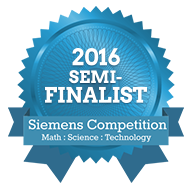Agarose Hydrogel Porosity

Project Overview
- Duration: June 2016 - August 2016
- My role: Research assistant working alongside Prof. Sean B. Andersson
- Tools & Frameworks: MATLAB, LabView, C++
 In the Summer of 2016, I applied through Boston University's RISE Internship Program
and was given the opportunity to work under Professor Andersson of the Mechanical Engineering Departement. My project consisted of utilizing
a novel technique of confocal microscopy to investigate the porosity of agarose hydrogels. My work later received a Semifinalist Award in the 2016
Siemens Competition in Math, Science & Technology, and was also later published in the Biomedical Optics Express Journal. Both papers that
I helped write are linked above!
In the Summer of 2016, I applied through Boston University's RISE Internship Program
and was given the opportunity to work under Professor Andersson of the Mechanical Engineering Departement. My project consisted of utilizing
a novel technique of confocal microscopy to investigate the porosity of agarose hydrogels. My work later received a Semifinalist Award in the 2016
Siemens Competition in Math, Science & Technology, and was also later published in the Biomedical Optics Express Journal. Both papers that
I helped write are linked above!
Motivation
Agarose hydrogel is an extremely useful polymer for the study of biological-physical phenomena. This is because of its structural similarity to living tissue which facilitates its application to biomedical technology. While there are several techniques for understanding it as a nanometer scale, the high production costs of hydrogels and sophisticated experimental setups can limit further developments. Thus, my lab's proposal attempted to use confocal microscopy to gain additional insights into the porosity of agarose.
Particle Tracking
In utilizing confocal microscopy, there needs to be a way to track the particle moving throughout the agarose hydrogel pores on a nanometer level scale. To solve this issue, quantum dot particles were introduced within the agarose samples and were tracked utilizing an intensity feedback algorithm to locate the extremum of the particle's point spread intensity function as the light from the microscope was reflected off the quantum dot. Then, the expectation-maximization (EM) algorithm was used with traditional Sequential Monte Carlo (SMC) techniques to probabilistically estimate the particle's motion parameters and its location. A more mathematical derivation of the algorithm can be found in the publication above.
Data Analysis
Once I was able to track the location of the particles as they diffused through the pores of the agarose hydrogel utilizing confocal microscopy, I then collected thousands of tracking runs to later perform analysis. After collecting the tracking runs, I wrote a script that could manually extract out the part of the run where the particle was moving within a pore of the agarose. From there, I utilized principal component analysis (PCA) and k-means clustering on the pore location data to estimate the pore size and location from the density and movement of these quantum dots within the pore. A more detailed analysis of my results and conclusion can be found in the Siemens paper and research poster linked above.
Reflections
This was my first time working under a professor in a laboratory setting, and it was a great learning experience for me to apply some of the math and computer science skills I learned in school to a research problem. I was extremely grateful that I was able to pick up the material quickly and contribute greatly to the project to even publishing a paper after given my limited experience coming in. I also learned a great deal about how meticulous research can be, and the amount of effort that truly goes into any given research problem since many things need to be designed from scratch, and so there are a lot of design choices and edge cases that need to be well-thought out. One thing that I continue to realize over summer was that in research, there is not a predefined answer to every question, and so some of the questions I had for my mentor were for me to find out myself! This experience also definitely helped me solidify my decision to pursue a computer science field.
Overall, I also really loved my summer back in my hometown of Boston, and here are some of my most favorite moments from my summer:
- Going on Pokemon Go runs (first summer the game came out) with my lab and other interns.
- Getting to drive one of Boston's famous Duck Tour boats.
- Watching the Red Sox at Fenway Park and seeing Patriots TE Rob Gronkowski make the opening pitch!
- Finishing my first escape room with fellow interns.
- Presenting my research at the Boston Univerisity RISE Symposium.